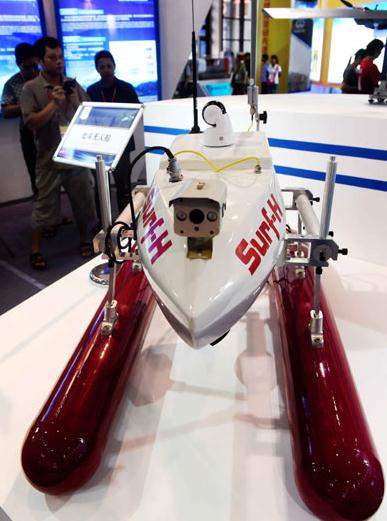
A model of an unmanned vessel equipped with the Beidou navigation system is displayed at the 9th China-Asean Expo in Nanning in the Guangxi Zhuang autonomous region in September. (Photo: Zhang Ailin/Xinhua)
Chinese satellite platform provides functionality that will meet needs around globe, top designer says
The Beidou Navigation Satellite System will help China carry out the Belt and Road Initiative, according to senior project officials.
Yang Changfeng, chief designer of the Beidou system, told China Daily that the Belt and Road Initiative have created a perfect platform and opportunity for the Beidou system to promote itself globally.
"The central government has included the system in the initiative's strategic plan, with top leaders repeatedly asking us to speed up the internationalization of Beidou to serve the development of China and other nations," Yang said.
The Belt and Road Initiative, a development strategy proposed by China in 2013, refers to the Silk Road Economic Belt, which will link China with Europe through Central and Western Asia, and the 21st Century Maritime Silk Road, stretching from southern China to Southeast Asia, and even to Africa.
"To date, the Beidou system has covered most parts of the Asia-Pacific region as well as countries along the Silk Road Economic Belt and 21st Century Maritime Silk Road," Yang said.
"It will offer Beidou-based navigation or positioning services to these nations in terms of cross-border transportation, fishing management, customs clearance and modern agriculture."
Ran Chengqi, director of the China Satellite Navigation Office, which oversees the Beidou project, said China is cooperating on satellite navigation with a host of countries, including Australia, Indonesia, Pakistan and Singapore.
"We are helping some countries in Southeast and South Asia plan for their ground applications of the Beidou system. We are also helping them build infrastructure so they can better use the system," he said.
China launched the first Beidou satellite in 2000. The system began providing positioning, navigation, timing and short-message services to civilian users in China and surrounding countries in the Asia-Pacific region in December 2012. The system now has 16 satellites.
Beidou is the fourth navigation satellite system in the world after the United States' GPS, Russia's GLONASS and the European Union's Galileo.
The latest satellite in Beidou's space network was put into orbit on March 30, marking the first step in expanding the network from a regional service to global coverage. The new-generation Beidou satellite has begun to test the new navigation signaling mechanism and intersatellite links.
China will launch up to four satellites for the Beidou network before the end of this year. The new-generation satellite has a longer life - at least 10 years compared to eight years for the old model. It also has higher accuracy - 2.5 meters rather than 10 meters.
According to the government's plan, the Beidou system will have 35 satellites by 2020, five of which will be in geostationary orbit.
















































